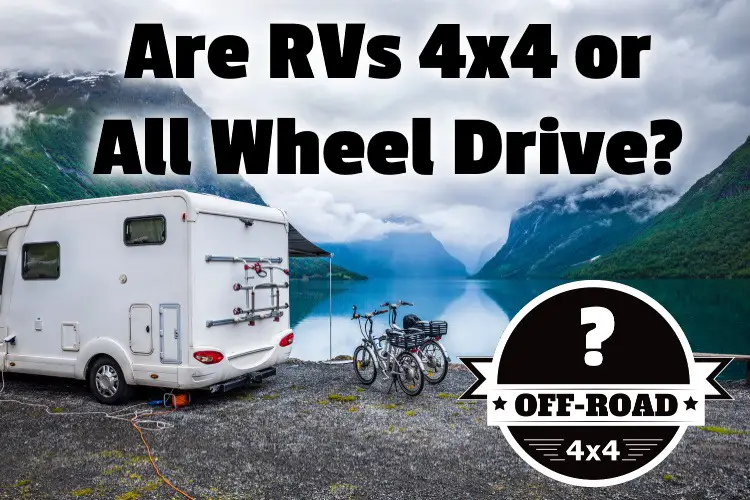
Most of the time, RVs are used on pristine highways. But, in some cases, you might want to tackle some off-road locations. So the question is, are RVs 4×4 or All Wheel Drive?
Here’s what I found out:
Most RVs are all-wheel drive, so it is rare for standard RVs to be 4×4. That being said, they do exist, most notably, the Earthroamer camper van. Most 4×4 RVs have been specially designed and customized using aftermarket parts. Going off-road is not recommended in standard AWD RVs.
In this article, we are going to take a look at the differences between AWD and 4×4.
We will also be talking about whether or not RVs are made for off-roading and if they are good for it. Lastly, we will be talking about one of our favorite RVs for off-road use and some alternatives.
So, for everything you need to know, keep reading.
AWD vs. 4×4: How do they perform Off-Road WATCH at: https://t.co/KTxf6RH78O pic.twitter.com/fn4E2tHx06
— Mark Higbee (@MarkHigbee) April 15, 2016
What are the differences between AWD and 4×4?
All-wheel-drive has all 4 tires activated at all times whereas 4×4 vehicles allow you to engage the front and/or rear wheels as needed. 4×4 vehicles also have a “low range” gear which turns the wheels very slowly for extremely rough terrain.
There is a misconception that AWD is just a different way of saying 4×4, but this is not true. In this section, we will look at a few of the key differences between AWD and 4×4.
4×4
- 4×4 vehicles are either front-wheel or rear-wheel drive, and the 4×4 needs to be activated when needed.
- 4×4 is not safe to use on normal driving surfaces because the components are not built to do so. If, for example, you drive on a wet tar road with 4×4 on, your vehicle will slip and slide a lot. It can also damage the axles of your vehicle.
- These vehicles are generally more fuel-efficient than AWD vehicles. Sending power to all four wheels uses more fuel. So, for everyday driving, a 4×4 vehicle is more fuel-efficient than an AWD vehicle.
- 4×4 vehicles tend to perform better than AWD vehicles when confronted with mild to extreme off-road terrain.
- On most 4×4 vehicles, they have a gear called “low range.” When used, your wheels will turn very slowly, which allows you to navigate extreme terrains safely.
AWD
- AWD is always on. The driver does not make any adjustments as it is all done by the vehicle.
- AWD vehicles are safer on the road than 2WD and 4×4 vehicles. This is because the vehicle sends the right amount of power to each wheel according to the terrain and what the vehicle is doing. So, taking a corner on a rainy day is a lot safer in an AWD vehicle.
- These vehicles are not as fuel-efficient as 2WD and 4×4 vehicles. This is because the AWD system is constantly sending power to all four wheels.
- While AWD vehicles can go off-roading, they tend to underperform compared to traditional 4×4.
- AWD performs better than any 2WD vehicle when it comes to normal driving. So that includes 4×4 because you should not be using the 4×4 feature on normal surfaces. You will find that a lot of sports vehicles come equipped with AWD.
- Most AWD vehicles do not have a “low range” gear.
Off-Road RVs Ready for Adventure https://t.co/atYPgxd23l pic.twitter.com/ubCJAtrx06
— Nik J Miles (@nikjmiles) June 2, 2019
Can RVs go off-road?
In most cases, a standard AWD RV should not be used off-road on rough or uneven terrain. Standard RVs are both long and tall and can easily tip over if they get off balance.
However, there are some cases where RVs can be used off-road if certain conditions are met. Let’s take a look at some of these conditions.
- Your RV must have off-road wheels.
- The RV should be under 25 feet long if the terrain is really rocky
- It is best to have a 4×4 RV, but an AWD one can suffice for milder road conditions
- Before going off-road, you need to secure all of your belongings such as the TV, microwave, cutlery, glasses, and dishes. You do not want anything to break.
But for me, in our Class A Newmar Baystar, I get nervous even on gravel and dirt roads. So you won’t find me blazing new trails off-road in mine.
Tiger Siberian adventure vehicle is perfect for #TheWalkingDead, has #solar power to keep you off the grid. https://t.co/yG4Sa1rzQ6 #luxury #cars #gadgets #LAAutoShow #LAAS2017 pic.twitter.com/WCbTlm2JPL
— TechEBlog (@techeblog) December 3, 2017
Do they make RVs designed for off-roading?
Yes. Companies like EarthRoamer and Tiger Adventure specialize in making RVs for off-road use. While they are pricey, they do tend to be smaller than many traditional RVs.
Traditionally, RVs are not designed to tackle off-road terrain. This is because they tend to be long and tall and could tip over easily on really uneven surfaces.
That being said, there are a few RVs that are built for off-road use.
Above I mentioned both EarthRoamer and Tiger Adventure Wheels. These companies make RVs specifically for off-roading. I get into all the details of both in the sections below. But do know that EarthRoamers start at $490,000 new.
Tiger Adventure, by comparison, starts closer to $250,000. Not cheap, but a whole lot cheaper.
They usually use the Ford lineup of pickup trucks as the base. So, these tend to resemble big camper vans. For bigger and more durable off-road RVs, companies like Unicat do a great job.
Some companies specialize in customizing stock RVs for their clients. They do this by using aftermarket parts. If you already own an RV, this is a great option as you could save some money.
It is up to you if you want to make any changes to your RV.
The EarthRoamer Camper is the Ultimate Outdoorsman RV hunting https://t.co/KS4Y8wovhJ pic.twitter.com/N0I7zEAGuP
— Dominator247 (@FreaknHunting) January 2, 2019
How much is the EarthRoamer camper?
EarthRoamer campers range in price from $490,000 to almost $2 million dollars depending on the model. However, used EarthRoamers can be purchased for as little as $270,000.
There are currently 3 models of the Earthroamer that are being sold as new. Let’s take a look at where all three of these models start in terms of price point.
EarthRoamer HD
The EarthRoamer HD starts at $1.7 million. This is the top-of-the-range model. The RV uses a Ford F-750 chassis with a 6.7L V8 Turbo Diesel engine that delivers 330 Horsepower. It also provides 2100 WATTS of solar power and batteries that can store 20,000 WATT hours.
EarthRoamer LTI
This mid-range EarthRoamer starts at $590,000 and goes up to $700,000 for a well-equipped one. The RV uses a Heavy Duty Ford F-550 6.7L Turbo Diesel. It provides 1300 WATTS of Solar Power with batteries that can store 11000 WATT hours.
EarthRoamer LTS
The EarthRoamer LTS starts at $490,000. The RV is very similar to the LTI with slightly fewer features.
The Peak of Luxury Off-Road Camping: The EarthRoamer XV-HD: When most people take to the road for a mobile home camping trip, it’s usually with a tow behind. Large and unwieldy RVs keep you from going to more exotic and interesting… https://t.co/tm2yRdeXAH #Cars #Autonews #NY pic.twitter.com/Dkb91p95SC
— Autotestdrivers.com (@Autotestdrivers) December 26, 2017
What is the best EarthRoamer alternative?
The Tiger Adventure Vehicle is one of the best alternatives to the EarthRoamer. You can use your own vehicle and have them install the camper, or you can buy the entire setup, including the Ford F-350.
Whether it has to do with pricing or perhaps you are not a fan of the EarthRoamer, don’t worry, there are alternatives, and we have selected the best based on our experience.
The price for the Tiger Adventure Vehicle starts at $92,000 and goes up to $200,000.
The reason that this vehicle stands out is due to its similarity to the EarthRoamer. It also costs a lot less, and if you bring your own pickup truck, you can still have that familiarity that you get with your vehicle while adding to it.
Have your RV customized
Another alternative is to have your RV customized so that it can go off-road. There are companies that specialize in this. Let’s take a look at what customizing your RV for off-roading might entail.
- The wheels will be changed to rugged off-road vehicles. The specifics might depend on whether you want “all-terrain wheels” or wheels for mud, dirt, or snow.
- The axles will be changed or at least raised. Because a 4×4 system uses a different axle setup, if you get a 4×4 system installed, your axles will be adjusted to include a transfer case between the two axles.
- Your RV might need to have a low-range gear added. In some cases, this can be done by adding a lever or electronic switch. In rare cases, your gearbox will be replaced or, hopefully, just modified.
- Some campers will be adjusted to withstand harsh environments. This includes adjustments to either the inside, outside or both.
Conclusion
Taking your RV off-road can be fun!
It is an adventure, but if your RV is not built for it, you will have a terrible time, and your RV might not survive the most extreme terrains.
It is important to understand what your RV needs if you want to take it on rugged terrains, and that was the goal of this article.
Be sure to bookmark this page as a reference if you are considering taking a trip that will include some off-road driving.
